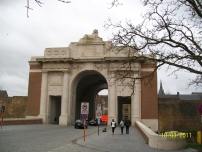| First Name: | David | Last Name: | BLOXHAM | |
|---|---|---|---|---|
| Date of Death: | 01/11/1914 | Lived/Born In: | Stoke Newington | |
| Rank: | Private | Unit: | Northumberland Fusiliers1 | |
| Memorial Site: | 1. Stoke Newington Library 2. Menin Gate, Ypres | |||
Current Information:Age-36 Coronation Avenue, Stoke Newington
The Race to the Sea. September-October 1914 By the middle of September 1914, the Aisne battlefield had stagnated into trench warfare and in order to break this impasse, both sides tried to outflank each other in a general movement northwards. Moving up through Picardy, Artois & Flanders, the race was over by 19th October when the North Sea was reached. The Western Front, a line of trenches stretching from Belgium to Switzerland, was now a reality. Initially it was the French army that conducted this movement whilst the British Expeditionary Force remained on the Aisne but by 6 October British reinforcements were needed to help beat off German attacks around Lille. They moved north and along with reinforcements from Britain, they took up new positions in Flanders, on the left of the Allied line and much closer to the Channel ports. The Battle of Messines 12th October-2nd November 1914 The Battle of Messines was fought in October 1914. It was part of the Race to the Sea and it took place between the Comines-Ypres canal and the River Douvre. It involved the 1st and 2nd Cavalry Divisions and elements of the 3rd, 4th and 5th Divisions as well part of the Indian Division. On 31st October 1st Northumberland Fusiliers of 9 Brigade, 3rd Division along with 1st Lincolnshire marched to Kemmel so as to be able to support the Cavalry at Wytschaete. At 1 am on 1st November, nine German battalions attacked and took Wytschaete from the Composite Household Cavalry who numbered only 415 rifles. 1st Lincolnshire and 1st Northumberland Fusiliers were ordered to retake it. Arriving within ¼ mile of Wytschaete, they attacked along with 3rd Hussars but met heavy rifle fire from the enemy who were now established in the houses and in a sunken road. French troops moving down from the north-west also failed to make progress here. When daylight arrived they withdrew having suffered casualties of nearly 100 in a few hours fighting. Among the dead was David Bloxham. |
||||
| « Back to Search Results | ||||
| If you think any of the information shown here is incorrect, Click Here to submit your amends and comments | ||||




